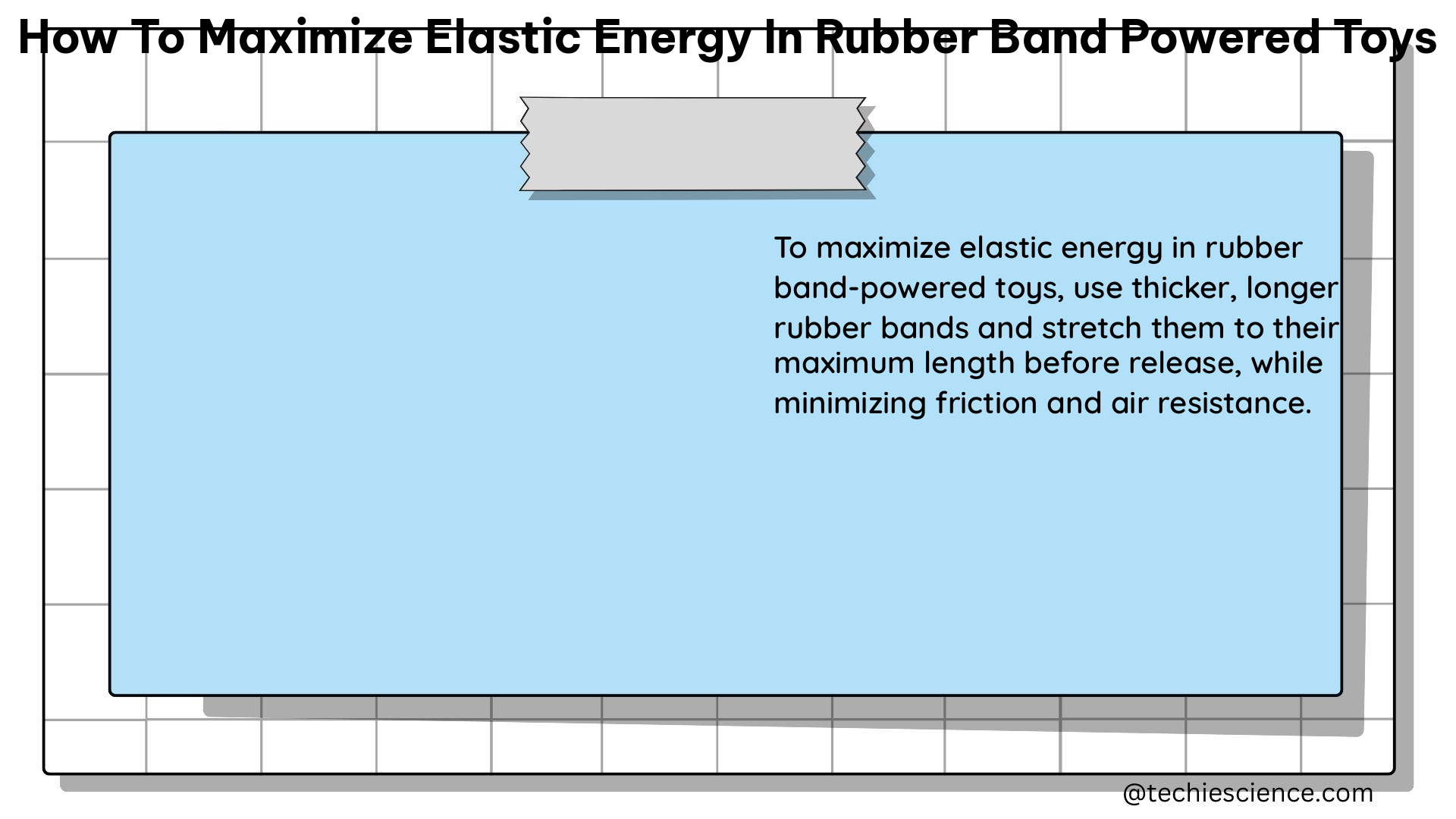Maximizing the elastic energy in rubber band powered toys is a fascinating exploration of physics principles, involving the transformation of potential energy into kinetic energy. By following a systematic approach, you can unlock the full potential of these captivating devices and gain a deeper understanding of the underlying concepts.
Understanding Potential and Kinetic Energy
The key to maximizing elastic energy in rubber band powered toys lies in the interplay between potential and kinetic energy. When you stretch a rubber band, you are increasing its potential energy, which is the energy stored due to its position or configuration. This stored potential energy is then converted into kinetic energy, the energy of motion, when the rubber band is released.
Measuring Stretch Length and Launch Distance

-
Stretch Length Measurement: Accurately measure the distance you stretch the rubber band using a ruler or a measuring tape. This distance directly affects the amount of potential energy stored in the rubber band. In the experiments referenced, the rubber band was stretched to 10 cm, 15 cm, 20 cm, and 25 cm.
-
Launch Distance Measurement: Measure the distance the rubber band travels after being launched. This distance is a direct measure of the kinetic energy of the rubber band.
Repeating Launches and Averaging Results
To ensure reliable data and minimize the impact of outliers, repeat the launches several times for each stretch length and calculate the average launch distance. This approach provides a more accurate representation of the relationship between potential and kinetic energy.
Graphing the Results
Plot the average launch distance on the y-axis and the stretch length on the x-axis. This visual representation will help you identify patterns and trends in the data, allowing you to optimize the performance of your rubber band powered toys.
Introducing Additional Variables
To further enhance the performance of your rubber band powered toys, consider introducing additional variables, such as the thickness and length of the rubber band. For example, in one of the referenced sources, a thicker, shorter rubber band was compared to a longer, thinner one.
Analyzing the Data
Utilize statistical methods, such as linear regression, to analyze the data and establish an equation that expresses the relationship between potential and kinetic energy in your rubber band powered toy system. This will provide a deeper understanding of the underlying physics principles and enable you to make informed decisions when designing and optimizing your toys.
Theorem: Conservation of Energy
The theorem that applies to this situation is the law of conservation of energy, which states that energy cannot be created or destroyed, only transformed from one form to another. In the case of rubber band powered toys, the potential energy stored in the stretched rubber band is transformed into kinetic energy when the rubber band is released.
Physics Formulas
-
Potential Energy (PE): The formula that relates potential energy to force (F), distance (d), and the spring constant (k) is: PE = 1/2 * k * d^2
-
Kinetic Energy (KE): The formula that relates kinetic energy to mass (m) and velocity (v) is: KE = 1/2 * m * v^2
Physics Examples
An example of potential energy is a book on a shelf. If you lift the book higher, you increase its potential energy. When you drop the book, its potential energy is converted into kinetic energy, which is the energy of motion.
Physics Numerical Problems
- Potential Energy Calculation: If a rubber band has a spring constant of 2 N/m and is stretched to a distance of 0.1 m, what is its potential energy?
- PE = 1/2 * k * d^2
- PE = 1/2 * 2 N/m * (0.1 m)^2
-
PE = 0.01 J
-
Kinetic Energy Calculation: If the rubber band has a mass of 0.01 kg and is moving at a velocity of 5 m/s, what is its kinetic energy?
- KE = 1/2 * m * v^2
- KE = 1/2 * 0.01 kg * (5 m/s)^2
- KE = 0.625 J
Figures, Data Points, Values, and Measurements
The key figures, data points, values, and measurements involved in this process include:
- Stretch length (10 cm, 15 cm, 20 cm, 25 cm)
- Launch distance (measured for each stretch length)
- Mass of the rubber band (0.01 kg)
- Velocity of the rubber band (5 m/s)
- Spring constant of the rubber band (2 N/m)
References
- Frugal Fun 4 Boys. (2023-07-28). Rubber Band Potential Energy Science Experiment. Retrieved from https://frugalfun4boys.com/rubber-band-potential-energy-science-experiment/
- Scientific American. (2018-01-11). Build a Rubber Band–Powered Car. Retrieved from https://www.scientificamerican.com/article/build-a-rubber-band-powered-car/
- Scientific American. (2012-04-05). Snappy Science: Stretched Rubber Bands Are Loaded with Energy. Retrieved from https://www.scientificamerican.com/article/bring-science-home-rubber-bands-energy/
By following this comprehensive guide, you can maximize the elastic energy in your rubber band powered toys and gain a deeper understanding of the underlying physics principles. Experiment, collect data, and analyze the results to unlock the full potential of these captivating devices.

The lambdageeks.com Core SME Team is a group of experienced subject matter experts from diverse scientific and technical fields including Physics, Chemistry, Technology,Electronics & Electrical Engineering, Automotive, Mechanical Engineering. Our team collaborates to create high-quality, well-researched articles on a wide range of science and technology topics for the lambdageeks.com website.
All Our Senior SME are having more than 7 Years of experience in the respective fields . They are either Working Industry Professionals or assocaited With different Universities. Refer Our Authors Page to get to know About our Core SMEs.